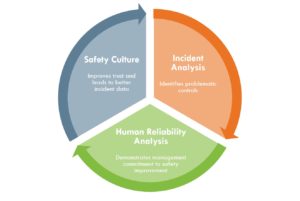
Safety
Comments: No Comments
The concept of human error and its contribution to occupational accidents and incidents have received considerable research attention in recent years. As mechanical systems become safer and more reliable, human error is more frequently being identified as the root cause of or a contributing factor to an incident (Health and Safety Executive, 1999). In order to effectively manage human error, companies must understand not only human error but also the factors contributing to it.
Kestrel has found that a multi-pronged improvement plan can help companies reduce the risks associated with employee and contractor behavior and, as a result, improve the safety performance of the organization. The three primary components of this approach include the following:
- Incident investigation and analysis – adapted from the Human Factors Analysis and Classification System (HFACS)
- Human Reliability Analysis (HRA) – based on the Cognitive Reliability and Error Analysis Method (CREAM)
- Comprehensive safety culture assessment and improvement initiative
Incident Investigation
Incident investigation and analysis is based on the premise that employee and contractor performance is a significant source of risk within any organization. The majority of accidents and other unintended events are, at least in part, the result of human error. Companies manage risks associated with employee and contractor behavior through a variety of controls (i.e., policies, standards, procedures) that address employee selection, training, supervision, operating practices, corrective and preventive actions, etc. Accidents occur when there is a failure in one or more of these controls.
The Human Factors Analysis and Classification System (HFACS; Wiegmann & Shappell, 2003) is very helpful for identifying human errors that contribute to a single incident and for helping to guide the appropriate corrective action. However, it doesn’t help companies identify the controls (e.g., engineered, administrative, PPE) that are most often failing to prevent incidents. Additionally, it is not designed for the aggregation of multiple incident analyses for the purposes of analyzing trends, similarities, and the statistical significance of the results.
So while the HFACS framework can be used to identify and classify human error(s) that contributed to the incident in question, the next steps are to 1.) identify and document the control(s) that failed to prevent each human error and 2.) describe the unique circumstances of the incident that were classified into that HFACS category. When aggregated, an incident analysis results in:
- A list of the most frequently occurring human factors, which are ranked according to their statistical significance
- Identification of the controls that are most frequently identified as failing to prevent the incidents in question
- A list of the specific circumstances associated with each error identification, to look for commonalities when planning systemic, rather than local, corrective action
This provides the company with the ability to identify where to focus corrective resources and how to best deploy those resources.
Human Reliability Analysis (HRA) and CREAM
There may be times when it is still difficult to create action plans to address the problematic controls; subsequently, a deeper analysis of the control is necessary in order to improve it. When this happens, Human Reliability Analysis (HRA) methods, specifically CREAM, help to further analyze the control.
HRA methods provide a detailed analysis of the potential for human error within a given process by observing the process step-by-step and evaluating the type(s) and the likelihood of error(s) that could occur at each step. The CREAM methodology, developed by Erik Hollnagel, focuses on the importance of cognition when attempting to identify, evaluate, and interpret potential human error.
Specifically, the CREAM method provides a framework for:
- Identifying the potential for human error in a process
- Describing the likelihood and nature of that error
- Evaluating if the potential for error requires action or if the existing risk is at an acceptable level
When the analysis is complete, it becomes possible to discuss viable options for deploying corrective action to improve the process (if necessary). These corrective actions can focus on the person, the operating environment, and/or the equipment involved in the process.
Safety Culture
Effective incident investigation and analysis and HRA function most effectively when a company exhibits an excellent safety culture. A strong safety culture has a number of characteristics in common. Kestrel’s research into the topic of safety culture has identified two traits that are particularly important to an effective safety culture: leadership and employee engagement. Best-in-class safety cultures have robust systems in place to ensure that each of these traits, among others, is mature, well-functioning, and fully ingrained into the standard practices of the organization.
Assessing safety culture can be done by administering a safety culture survey, conducting interviews of key leadership and safety personnel, and leading focus groups with front-line employees and supervisors. The mix of quantitative data (survey) and qualitative information (interviews and focus groups) provides data that can then be statistically analyzed, as well as a rich context for the results of the statistical analysis.
Performing a safety culture survey also provides an “as-is” benchmark for comparing future survey results to determine if improvement efforts have been effective and have fully permeated into all levels and units across the organization.
Realizing the Richest Benefit
While the individual components discussed above can be very helpful to a company, deploying them in tandem provides the richest and most comprehensive benefit to company safety performance.
That is because the three components are inherently complementary. Each improves the effectiveness of the others. For example, safety culture improvements, specifically, improvements in mutual trust and respect between levels of the organization, lead to better incident investigation data. This is because employees feel free to provide honest and complete narratives of the incident since they know they will not be unfairly disciplined for what happened. As a result, incident investigation and analysis is better able to identify the human errors and, most importantly, the controls that are most often involved in incidents.
All of this then allows the company to identify the processes and procedures that may be appropriate candidates for HRA. Subsequently, corrective actions that result from both incident investigation/analysis and HRA demonstrate to employees that management is committed to continuous safety improvement, which further improves safety culture.
